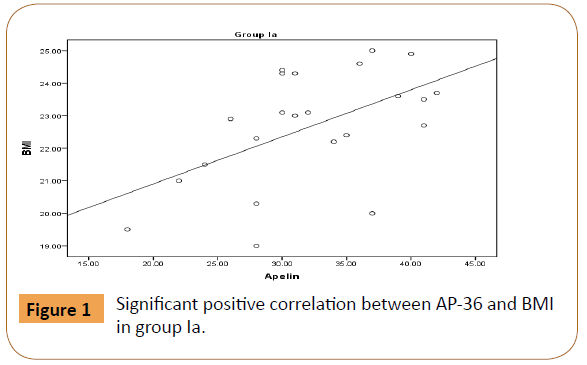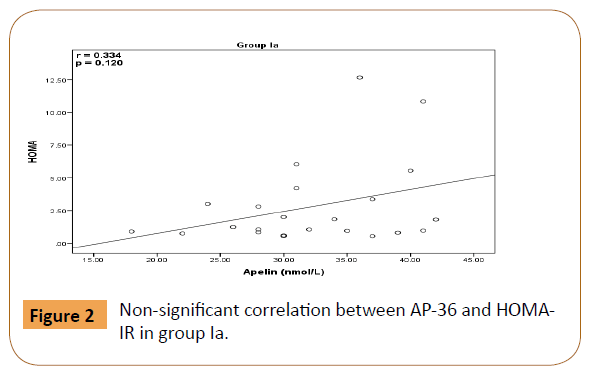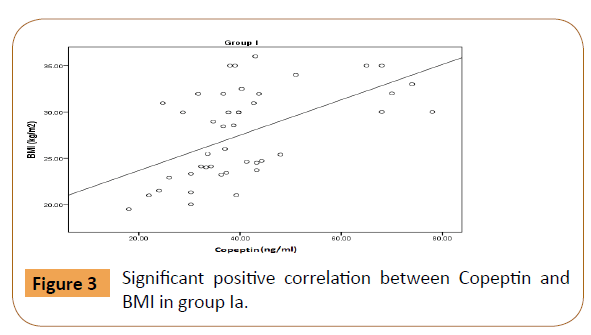Keywords
PCOS; Apelin-36; Copeptin; BMI
Introduction
PCOS is a functional disorder of unclear etiology and as such is a diagnosis of exclusion with other androgen excess and ovulatory disorders of clearly defined etiologies excluded. Androgen excess disorders to be excluded are 21-hydroxylase deficient non classic adrenal hyperplasia, adrenal or ovarian androgen-secreting tumors, disorders of generalized adrenocortical dysfunction (e.g., Cushing’s disease) and use or abuse of androgenic or anabolic drugs [1].
Obesity may impact the risk of PCOS via insulin resistance and compensatory hyperinsulinemia (HI), which augments ovarian/adrenal androgen production and suppresses sex hormone binding globulin (SHBG), thereby increasing androgen bioavailability. Altered LH secretion plays an important role in the pathophysiology of PCOS and although obesity is generally associated with relative reductions of LH, higher LH appears to be the best predictor of increased free testosterone among peripubertal girls with obesity. Other potential mechanisms of obesity-associated hyperandrogenemia include enhanced androgen production in an expanded fat mass and potential effect of abnormal adipokine/cytokine levels [2].
Insulin resistance is considered the main pathogenic factor in the background of increased metabolic disturbances in women with PCOS menstrual irregularity and other metabolic manifestations seen in this disease but it is not a diagnostic criterion for PCOS [3].
Adipose tissue acts as an enormous endocrine organ secreting a variety of signaling molecules that regulate feeding behavior, energy spending, metabolism, reproduction and endocrine and immune function [4].
Adipocyte hypertrophy in PCOS may be a consequence of variations in storage and/or adipocyte lipolytic capacity. Thus, obesity in women with PCOS is mainly characterized by an increase in fat cell size (hypertrophic obesity) rather than an increase in fat cell number (hyperplastic obesity) [5].
Apelin (AP) is an endogenous cytokine synthesized and secreted by adipocytes [6]. AP seems to be a key regulator in glucose and lipid metabolism and may be associated with IR and PCOS is known to be associated with increased IR [7].
Copeptin, the C-terminal portion of the precursor of vasopressin, is considered to be a reliable and clinically useful surrogate marker for vasopressin which influences gluconeogenesis and glycogenolysis in the liver [8] insulin and glucagon release by the Langerhans islets of the pancreas and adrenocorticotrophic hormone release from the anterior hypophysis [9].
The aim of this work is to study the role of apelin-36 and copeptin in the pathogenesis of PCOS and their correlation with other hormonal and metabolic parameters associated.
Patients and Methods
This study was conducted in El-Minia University hospital, from the period of March to September 2015. Fifty patients with PCOS (group I) (their ages ranging from 19 to 34 years, subdivided according to BMI into Subgroup ÃÆÃâÃâÃÂÃÆââ¬Å¡Ã¢ââ¬Ã a: BMI <25 kg/m2 (n=23) and Subgroup Ib: BMI ≥ 25 kg/m2 (n=27)) and thirty apparently healthy women (group II) (their ages ranged from 19 to 32 years subdivided according to BMI into Subgroup ÃÆÃâÃâÃÂÃÆââ¬Å¡Ã¢ââ¬Ã Ia: BMI <25 kg/m2 (n=12) and Subgroup IIb: BMI ≥ 25 kg/m2 (n=18) were recruited for this study after their approval.
PCOS women were diagnosed according to the Rotterdam criteria (Rotterdam ESHRE/ASRM, 2003). Exclusion criteria including: Nonclassic congenital adrenal hyperplasia due to21-α hydroxylase deficiency, Hyperprolactinemia, 1ry hypothyroidism, Acromegaly, Premature ovarian failure, Virilizing ovarian neoplasia, Drug, metabolic, hepatic, or cardiovascular related condition or other concurrent medical illness (e.g., diabetes mellitus, renal insufficiency, or malabsorption disorders), Women who are intending to start a diet or a specific program of physical activity.
In the early follicular phase (day 3-5 of the menstrual cycle); Body Mass Index (BMI) was calculated using the following formula: weight in kilograms/height in meters squared (kg/m2) then 5 ml of venous blood were withdrawn from each subject by sterile venipuncture into plain tube and left to be clotted then centrifuged at 3000 rpm for 15 mins, the expressed serum was used for the assay of blood glucose and lipogram using fully automated chemistry analyzer (Konelab 20i, Thermo Electron Incorporation, Finland), hormonal profile was done using miniVIDAS analyzer (Biomerieux Italia 5.P.A), the remaining serum was kept frozen at -20°C for determination of insulin by ELISA (Immunospect Corporation, Canoga Park, CA), apelin by ELISA (Genasia Biotech Co., Ltd, Shanghai China) and copeptin (Raybiotech, USA).
Data entry and analysis were done using software SPSS version 19. Graphics were done using Excel. Quantitative data were presented by mean and standard deviation, while qualitative data were presented by frequency distribution. Student t test and Chi-square test was used to compare qualitative variables between groups. The probability of less than 0.05 was used as a cut off point for all significant tests.
Results
All obtained results of different groups were summarized in Tables 1 and 2; Figures 1-3.
Figure 1: Significant positive correlation between AP-36 and BMI in group Ia.
Figure 2: Non-significant correlation between AP-36 and HOMAIR in group Ia.
Figure 3: Significant positive correlation between Copeptin and BMI in group Ia.
| Variables |
Group I (n=50) |
Group II (n=30) |
P -value |
| Ia(n=23) |
Ib(n=27) |
IIa(n=12) |
IIb(n=18) |
Ia-Ib |
Ia-IIa |
Ib-IIb |
| |
|
|
|
|
|
|
|
| (19-34) |
(19-30) |
|
(19-33) |
(20-32) |
0.041* |
0.199 |
0.5 |
| Mean ± SD |
23.43 ± 3.15 |
25.59 ± 3.95 |
25.16 ± 4.62 |
26.2 ± 4.0 |
|
|
|
| BMI |
|
|
|
|
<0.001* |
0.109 |
0.088 |
| Range |
(19-24.8) |
(25.4-36) |
(21-24.7) |
(27-33) |
| Mean ± SD |
22.66 ± 1.73 |
31.14 ± 2.9 |
23.58 ± 1.13 |
29.77 ± 1.98 |
| FBG |
|
|
|
|
0.123 |
0.733 |
0.978 |
| Range |
(70-109) |
(74-110) |
(69-108) |
(75-110) |
| Mean ± SD |
87.65 ± 13.42 |
93.14 ± 11.32 |
89.41 ± 16.16 |
93.05 ± 10.21 |
| Fasting insulin |
|
|
|
|
0.002* |
0.986 |
0.005* |
| Range |
(3.1-35) |
(3.2-50) |
(0.8-8.9) |
(0.65-13) |
| Mean ± SD |
8.51 ± 5.98 |
17.7 ± 12.42 |
6.02 ± 2.51 |
7.21 ± 3.66 |
| HOMA-IR |
|
|
|
|
0.028* |
0.498 |
0.006* |
| Range |
(0.54-12.66) 2.79 ± 2.24 |
(0.87-12.46) |
(0.2-1.73) |
(0.13-3.14) |
| Mean ± SD |
|
4.02 ± 2.57 |
1.31 ± 0.54 |
1.66 ± 0.88 |
Table 1. Demographic data, FBG, fasting insulin and HOMA-IR of the studied groups.
| Variables |
Group I (n=50) |
Group II (n=30) |
P-value |
| Ia(n=23) |
Ib(n=27) |
IIa(n=12) |
IIb(n=18) |
Ia-Ib |
Ia-IIa |
Ib-IIb |
| FSH |
|
|
|
|
0.054 |
<0.001* |
0.043* |
| Range |
(1.3-7.2) |
(1.7-12.3) |
(5.4-8.1) |
(5.1-8.9) |
| Mean ± SD |
4.54 ± 1.67 |
5.78 ± 2.58 |
6.96 ± 0.93 |
7.11 ± 0.94 |
| LH |
|
|
|
|
0.172 |
0.159 |
0.002* |
| Range |
(3.1-12.6) |
(1.1-15.1) |
(3.8-7) |
(3-6.4) |
| Mean ± SD |
6.18 ± 2.96 |
7.46 ± 3.46 |
5.19 ± 1.05 |
5.04 ± 0.93 |
| LH/FSH |
|
|
|
|
0.697 |
0.001* |
<0.001* |
| Range |
(0.46-3.38) |
(0.12-7.18) |
(0.67-.88) |
(0.59-.85) |
| Mean ± SD |
1.51 ± 0.74 |
1.63 ± 1.33 |
0.74 ± 0.06 |
0.71 ± 0.06 |
| fT |
|
|
|
|
0.392 |
0.006* |
0.002* |
| Range |
(0.8-10.3) |
(0.7-13) |
(0.5-3.9) |
(0.7-4.5) |
| Mean ± SD |
4.54 ± 2.87 |
5.5 ± 3.44 |
1.73 ± 0.94 |
2.05 ± 1.04 |
| E2 |
|
|
|
|
0.809 |
<0.001* |
<0.001* |
| Range |
(23-83) |
(18.84-90.5) |
(76.19- 251) |
(81.5-250) |
| Mean ± SD |
57.55 ± 13.51 |
58.51 ± 13.97 |
172.26 ± 61.6 |
163.27 ± 67.3 |
| Prolactin |
|
|
|
|
0.934 |
0.989 |
0.942 |
| Range |
(3.84-27) |
(2-26.6) |
(1.61-26.6) |
(3.45-25) |
| Mean ± SD |
14.9 ± 6.15 |
14.74 ± 7.44 |
14.86 ± 7.64 |
14.58 ± 6.55 |
| fT4 |
|
|
|
|
0.828 |
0.636 |
0.313 |
| Range |
(10.8-19.6) |
(10.4-18.4) |
(10.3-19.3) |
(11.8-19.4) |
| Mean ± SD |
13.66 ± 2.8 |
13.82 ± 2.38 |
14.28 ± 4.73 |
14.56 ± 2.31 |
| TSH |
|
|
|
|
0.477 |
0.122 |
0.618 |
| Range |
(0.52-6.5) |
|
(1.02-2.5) |
(0.74-3.5) |
| Mean ± SD |
1.89 ± 1.47 |
(0.62-4.9) |
2.0 ± 0.51 |
1.66 ± 0.73 |
| |
|
1.92 ± 1.12 |
|
|
| AP-36 |
|
|
|
|
0.001* |
0.341 |
0.002* |
| Range |
(18-42) |
(22-78) |
(23-41) |
(14-43) |
| Mean ± SD |
32.17 ± 6.43 |
44.25 ± 5.61 |
30.08 ± 5.26 |
32.33 ± 7.93 |
| Copeptin |
|
|
|
|
0.003* |
0.138 |
0.003* |
| Range |
(1.6-4.1) |
(2.3-7.5) |
(2.4-3.95) |
(1.5-4.3) |
| Mean ± SD |
3.12 ± 1.98 |
4.0 ± 1.51 |
2.98 ± 1.95 |
3.2 ± 1.10 |
Table 2. Hormonal profile, apelin-36 and copeptin of the studied groups.
Discussion
In the present study, apelin-36 and copeptin levels were increased in patients with PCOS when compared to control group (P-value=0.002, 0.003). There were increased AP-36 and Copeptin levels in obese PCOS patients with positive correlation with insulin levels and HOMA-IR levels in obese PCOS when compared with BMI matched control (P-value=0.002, 0.003) while when comparing non-obese PCOS and non-obese control there was non-significant difference (P-value=0.341, 0.138).
These results were in agreement with Ref. [10] who reported lower AP-36 level in non-obese PCOS when compared to obese PCOS and higher AP-36 level in obese PCOS when compared to obese control and Ref. [11] who found higher copeptin levels in PCOS patients and Ref. [12] who reported enhanced copeptin levels in obese PCOS women when compared with non-obese PCOS.
In the current study, we observed that AP-36 levels were significantly and positively correlated with BMI in PCOS group (r=0.529, P<0.001) and in non-obese PCOS (r=0.536, P=0.008). There was non-significant fair positive correlation between AP-36 and age and LH/FSH ratio and non-significant weak correlation with FBG, fasting insulin, HOMA-IR, TG, TC, HDL, LDL, FSH, LH, fT, E2, prolactin, fT4 and TSH in PCOS group. There was non-significant fair positive correlation between AP-36 and age and HOMA-IR and non-significant weak correlation with FBG, fasting insulin, TG, TC, HDL, LDL, FSH, LH, LH/FSH ratio, fT, E2, prolactin, fT4 and TSH in non-obese PCOS group. While in obese PCOS group; there was non-significant fair positive correlation between AP-36 and BMI and LH/FSH ratio, non-significant fair negative correlation between AP-36 and FBG, fasting insulin and HOMA-IR and nonsignificant weak correlation with age, TG, TC, HDL, LDL, FSH, LH, fT, E2, prolactin, fT4 and TSH.
Our results were in disagreement with Ref. [13] and Ref. [14] who declared no association between AP-36 level, HOMA-IR and BMI. This may be due to HOMA-IR based on fasting glucose and insulin levels primarily and AP improves in vivo glucose metabolism by increasing glucose utilization in insulin sensitive tissues, most likely in an insulin-independent manner rather than through inhibition of hepatic glucose output [14]. These facts might be behind the lack of correlation between AP levels and HOMA-IR.
In the present study there was significant decreased FSH level and increased LH level in PCOS group when compared to control group (P-value=<0.001) and there was non-significant difference between obese and non-obese PCOS subgroups and these results were in agreement with Ref. [10] who reported that there was statistically significant decreased FSH level and increased LH level in PCOS subgroups when compared to BMI matched control subgroups.
These results further confirm that high LH level and relative insufficiency of FSH are the characteristics of PCOS.
In the current study free testosterone (fT) level was significantly higher in PCOS when compared to control group (P-value<0.001) and in PCOS subgroups when compared to BMI matched control subgroups. Increased LH level probably plays an important role in the pathological mechanism of the higher androgens production in the ovaries, which can interfere with the maturation of the oocyte. This result suggests that hypertestosteronemia is actively involved in the pathogenesis of PCOS regardless of obesity [10].
The present study showed that there was statistically significant decreased E2 level in PCOS group when compared to control group (P-value<0.001) and in PCOS subgroups when compared to BMI matched control subgroups. This was in agreement with [10] who reported that there was non-significant difference between PCOS subgroups and between PCOS subgroups and BMI matched control subgroups. Discrepant findings among the published studies may be attributed to the differences in ethnicity, age, study design, genetic characteristics of populations and assessment methodology. Therefore further studies are required in larger cohorts with different genetic backgrounds.
Conclusion
• Increased AP-36, copeptin, fasting insulin level and HOMAIR in Obese PCOS patients than non-obese PCOS.
• According to our data, AP-36 and copeptin is not directly implicated in the pathogenesis of PCOS, but they may be involved as an adipokines affected by BMI.
References
- Witchel S, Oberfield S, Rosenfield R, Codner E (2015) The diagnosis of polycystic ovary syndrome during adolescence. Horm Res Paediatr 83: 376-89.
- Anderson A, Solorzano C, Mc Cartney C (2014) Childhood obesity and its impact on the development of adolescent PCOS. Semin Reprod Med 32: 202-213.
- Samer E, Lynn B, Layal H, Fadi G, Georges D, et al. (2016) Polycystic Ovarian Syndrome: An Updated Overview. Frontiers in Physiology 7: 1-16.
- Rexford SA, Laura MS, Hyeong-Kyu P (2016) metabolic syndrome: Adipokines and metabolism. Springer International Publishing Switzerland 22: 397- 421.
- Vanessa P, Stefania C, Antonio V (2016) Adipose tissue plasticity: how fat depots respond differently to pathophysiological cues. Diabetologia 59: 1075–88.
- Wen-Ya M, Tse-Ya Y, Jung-Nan W, Chi-Sheng H (2014) Plasma apelin: A novel biomarker for predicting diabetes. Clinica Chimica Acta 435: 18–23.
- Sündüzö Z, Sümeyra N, Mert K (2014) AP levels in relation with hormonal and metabolic profile in patients with PCOS. European Journal of Obstetrics & Gynecology and Reproductive Biology 176: 168-172.
- Holmes CL, Landry DW, Granton JT (2003) Vasopressin and the cardiovascular system part 1—receptor physiology. Crit care 7: 427–434.
- Enhorning S, Bankir L, Bouby N, Struck J, Hedblad B, et al (2013) Copeptin, a marker of vasopressin, in abdominal obesity, diabetes and microalbuminuria: the prospective Malm Diet and Cancer Study cardiovascular cohort. International J. of Obesity 37: 598–603.
- Xianchang S, Xingguo W, Yan Z, Xinyan Y, Wenjuan Z (2015) Evaluation of apelin and insulin resistance in patients with PCOS and therapeutic effect of drospirenone-ethinylestradiol plus metformin. Med Sci Monit 2547-2552.
- Karbek B, Ozbek M, Karakose M, Topaloglu O, Bozkurt NC, et al. (2014) Copeptin, a surrogate marker for arginine vasopressin, is associated with cardiovascular risk in patients with polycystic ovary syndrome. J. Ovarian Res 14: 31-55.
- Taskin MI, Bulbul E, Adali E, HismiogullarÃÆÃââââ¬Ã
¾ÃÆââ¬Å¡Ãâñ AA, Inceboz U (2015) Circulating levels of obestatin and copeptin in obese and non-obese women with polycystic ovary syndrome. Eur J. Obstet Gynecol Reprod Biol 189: 19–23.
- Chang C, Tsai Y, Lee C, Chan T (2011) Lower serum apelin levels in women with polycystic ovary syndrome. Fertility and Sterility 95: 2520.e2–3.e2.
- Choi YS, Yang HI, Cho S (2012) Serum asymmetric dimethyl arginine, apelin, and tumor necrosis factor-alpha levels in non-obese women with polycystic ovary syndrome. Steroids 77:1352–1358.



